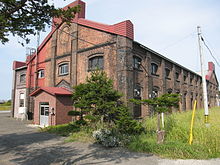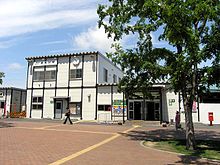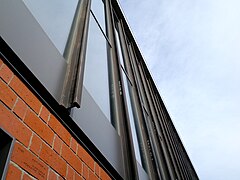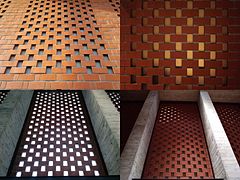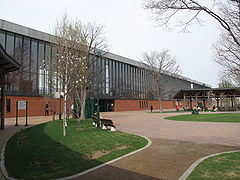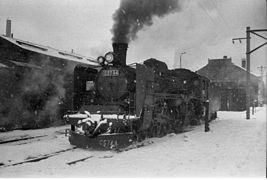Iwamizawa Railway Station
| Iwamizawa ( 岩 見 沢 ) | |
|---|---|
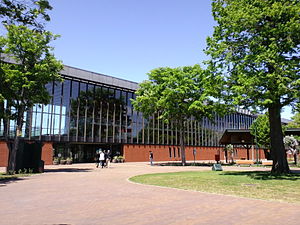 View of the train station (June 2013)
|
|
| Data | |
| Location in the network | Separation station |
| Platform tracks | 5 |
| abbreviation | A13 |
| opening | August 15, 1884 |
| Architectural data | |
| architect | Hiroshi Nishimura |
| location | |
| City / municipality | Iwamizawa |
| prefecture | Hokkaidō |
| Country | Japan |
| Coordinates | 43 ° 12 '15 " N , 141 ° 45' 35" E |
| Height ( SO ) | 19 m TP |
| Railway lines | |
|
Decommissioned: |
|
| List of train stations in Japan | |
The Iwamizawa Station ( Jap. 岩見沢駅 , Iwamizawa-eki ) is a train station on the Japanese island of Hokkaido . It is located in Sorachi Sub-Prefecture, Iwamizawa City . The new construction of the station, built in 2007, is considered an architectural masterpiece and has received numerous prizes, including the Brunel Award .
links
Iwamizawa is a separation station on the Hakodate Main Line between Sapporo and Asahikawa , Hokkaidō's most important railway line. From this the Muroran main line branches off in the direction of Muroran and Oshamambe . Both lines are operated by the JR Hokkaido company.
In long-distance traffic on the Hakodate main line, the Super Kamui express train, which runs every 30 or 60 minutes, provides the fastest connection with Sapporo and Asahikawa. This offer is supplemented by the Super Sōya and Sarobetsu express trains from Sapporo to Wakkanai and the Ochotsk express train from Sapporo to Abashiri . In addition, there is the “Lavender Express” from Sapporo to Furano on certain days in summer .
Due to its location on the edge of the Sapporo agglomeration, Iwamizawa station plays an important role in regional traffic . A regional train runs on the Hakodate main line to Sapporo every 15 to 30 minutes on average . In addition, express trains called Ishikari Liner run via Sapporo to Teine and Otaru . Regional trains in the direction of Takikawa usually run every hour. Seven regional trains to Tomakomai are offered daily on the Muroran main line .
There is a bus terminal next to the train station , which is served by various city, regional and long-distance bus routes operated by the Hokkaidō Chūō Bus company.
investment
The station on the edge of the city center is oriented from southwest to northeast. It has twelve tracks, five of which are used for passenger traffic. They are located on the house platform and on two central platforms . A covered overpass connects the central platforms with the station building on the southeast side of the facility, and another overpass connects the southern and northern station forecourt. To the north of the station is an extensive depot , the main building of which from 1899 is one of the Japanese Railway Monuments.
The present reception building from 2007 replaced the previous wooden building from 1933, which had burned down seven years earlier. In 2005, JR Hokkaido was the first Japanese railway company to hold an open architectural competition , whereupon 376 designs were submitted. The design by Hiroshi Nishimura was awarded the contract. The new building has been awarded over a dozen architecture prizes. These include, among other things, the highest award level (Grand Award) of the Good Design Award given by the Japanese funding organization for industrial design , the Brunel Award for outstanding train stations and the “Award for Outstanding Architecture” from the Japanese Institute of Architects . The striking three-storey new building with a length of 45 m and a height of 12 m was built mainly from dark red brick . The bricks inside are partly put together to form artistic patterns, while the curtain wall on the main front consists of recycled rails.
A wooden sculpture by the sculptor Tsukasa Nakagawa stands on platform 3/4. It depicts a draft horse with a sledge and was set up there in 1980 to advertise the Ban'ei horse races typical of Hokkaidō on the nearby (now closed) racetrack.
Tracks
| 1 | ▉ Hakodate main line | Sapporo • Otaru |
| ▉ Muroran main line | Oiwake • Tomakomai | |
| 3 | ▉ Hakodate main line | Sapporo • Otaru |
| ▉ Muroran main line | Takikawa • Asahikawa | |
| ▉ Muroran main line | Oiwake • Tomakomai | |
| 4th | ▉ Hakodate main line | Sapporo (especially express trains) |
| 6th | ▉ Hakodate main line | Asahikawa • Wakkanai • Abashiri (especially express trains) |
| 7th | ▉ Hakodate main line | Sapporo • Otaru |
| ▉ Hakodate main line | Takikawa • Asahikawa |
history
The state railway company Horonai Tetsudō opened on November 13, 1882 a section of the Hakodate main line , which led from Sapporo to Iwamizawa. This was followed by the Horonai Line to Ikushumbetsu, which opened on the same day , which now provided a continuous rail connection from the port of Otaru to the center of the Ishikari coal field , which is currently being built . The development of the hard coal deposits had priority, so that no passengers were carried at the beginning. This changed on August 15, 1884 with the establishment of a demand stop in Iwamizawa. The first station building was built in November 1885. In 1889 the Horonai Tetsudō went to the private mining and railway company Hokkaidō Tankō Tetsudō ; the new owner extended the route on July 5, 1891 to the Sorachi Bridge near Takikawa . On August 1, 1892, she began operating the first section of the Muroran Main Line from Iwamizawa to Muroran .
From 1898 Iwamizawa was the location of a railway depot. The Hokkaidō Tankō Tetsudō moved its headquarters from Sapporo here, but on October 1, 1906, it was nationalized . From 1914 to 1985, Iwamizawa was the starting point for all trains running on the Manji Line , which branches off in the neighboring Shibun Station . The Ministry of Railways expanded the Hakodate main line in stages to double track: in 1909 between Ebetsu and Iwamizawa, in 1923 between Iwamizawa and the temporary Higashioka siding. On August 28, 1968 , the Japanese State Railways (JNR) electrified the section Otaru – Sapporo – Iwamizawa – Takikawa. On December 14, 1975, the last steam-powered passenger train in Japan ran from Iwamizawa to Muroran on the Muroran Main Line . As part of the privatization of the state railway, the station passed into the possession of JR Hokkaido on April 1, 1987 . A little more than three months later, on July 13, 1987, this shut down the Horonai line.
Due to a gas leak, the station building burned down completely on December 10, 2000. JR Hokkaido then erected a temporary replacement building from prefabricated parts within 24 days. The planning phase for a new building dragged on for almost five years because the city authorities wanted to use this opportunity to completely redesign the station district. The result of the architectural competition was announced on March 5, 2005, and the new station building was provisionally opened on June 23, 2007. The project was completed on March 30, 2009.
photos
Adjacent train stations
|
←
|
Lines |
→
|
||
|---|---|---|---|---|
| Kami-Horomui |
JR Hokkaido |
Minenobu | ||
| Shibun |
JR Hokkaido |
The End | ||
| Beginning |
JR Hokkaido |
Sakaemachi | ||
| Shibun |
Japanese State Railways |
The End | ||
Web links
- JR Hokkaido Station Information (Japanese)
Individual evidence
- ^ JR Hokkaido railway lines in Sapporo area. (PDF, 986 kB) JR Hokkaido, accessed on July 9, 2016 (English).
- ^ Station and Compound Building Iwamizawa. Good Design Award, 2009, accessed on July 9, 2016 .
- ↑ 11th Brunel Awards 2011. (No longer available online.) Watford Group, 2011, archived from the original on July 8, 2016 ; accessed on July 9, 2016 . Info: The archive link was inserted automatically and has not yet been checked. Please check the original and archive link according to the instructions and then remove this notice.
- ↑ 2010 年度 「日本 建築 家 協会 優秀 建築 選 100 選」. (PDF, 211 kB) Japanese Institute of Architects, 2010, accessed on July 9, 2016 (Japanese).
- ↑ ば ん え い DRAFT RACE No.11. (PDF, 14.2 MB) (No longer available online.) Hokkaidō shiei keiba kyōgi kai, 1981, archived from the original ; Retrieved July 9, 2016 (Japanese).
- ↑ Kazuo Tanaka: 写真 で 見 る 北海道 の 鉄 道 (Hokkaidō's railroad in photos) . tape 1 . Hokkaidō Shinbunsha, Sapporo 2002, ISBN 978-4-89453-220-5 , pp. 36-37 .
- ↑ Tanaka: 写真 で 見 る 北海道 の 鉄 道, p. 311.
- ↑ Tanaka: 写真 で 見 る 北海道 の 鉄 道, pp. 60–61.
- ^ The Last Days of Japanese Steam Engines. (No longer available online.) In: A profile of Japanese steam locomotives. Good Old Rail, archived from the original on September 13, 2016 ; accessed on July 9, 2016 .
- ↑ 岩 見 沢 駅 全 焼 駅 員 、 作 動 の 警報 機 切 る 119 番 通報 20 分 後 に. Hokkaidō Shimbun, December 11, 2000.
- ↑ JR 岩 見 沢 駅 仮 駅 舎 が 完成. Hokkaidō Shimbun, December 11, 2000.
- ↑ 岩 見 沢 複合 駅 舎 全面 オ ー プ ン. Hokkaidō Shimbun, March 31, 2009.
